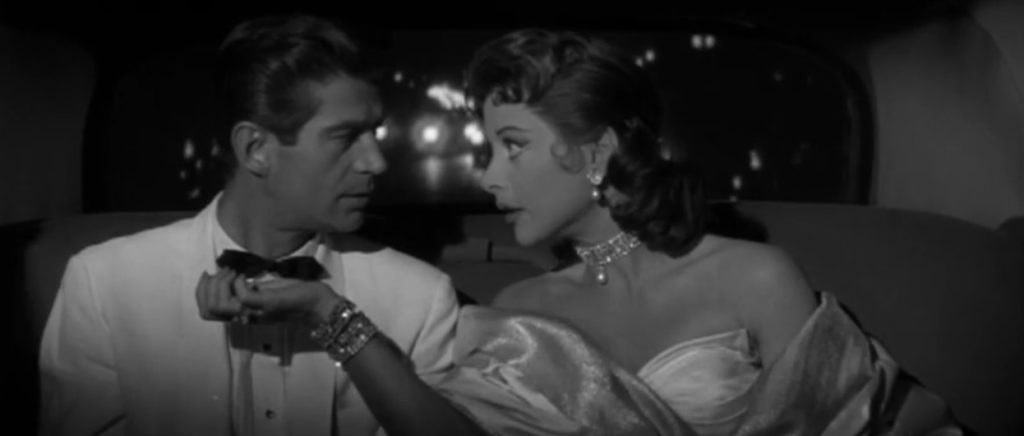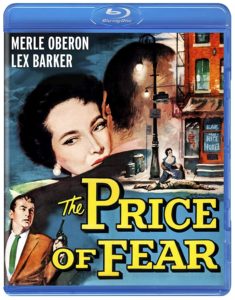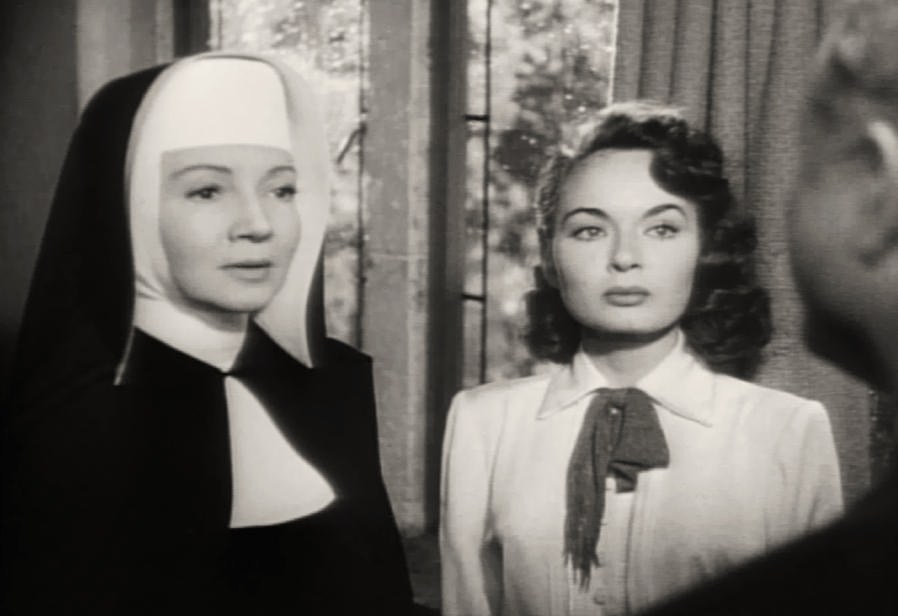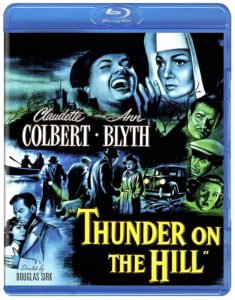The Female Animal (1958) / The Price Of Fear (1956) /Thunder On The Hill (1951)
BOX SET STREET DATE: MAY 12, 2020/KL STUDIO CLASSICS

Kino Lorber Studio Classics sequelizes its dynamite five-film 2016 collection, “Film Noir: The Dark Side of Cinema” with this three-disc junior-level outing. Presenting three otherwise unrelated 1950’s titles from Universal International (1958’s The Female Animal, 1956’s The Price of Fear, and 1951’s Thunder on the Hill), this set pushes the boundaries of what movie buffs are expected to consider “Film Noir”. The contextualization, however, cannot be ignored, as it is the primary selling point of this set. As you will see, each of these films is precariously Noir to varying degrees. The question then becomes, to what degree can the hardcore and attractive branding be overlooked in favor of simply having these three diverse and unknown films as decent new Blu-rays? Is an aspect of “darkness” in films made between Huston’s The Maltese Falcon and Welles’s Touch of Evil enough to render them true “Film Noir”? Let’s take a look at each title…
The Female Animal
DIRECTED BY HARRY KELLER/1958


Some temptations are simply too much to resist. Film Noir, with its devious femmes fatales and greed-driven macguffins, proves to demonstrate this point again and again. Perhaps this ageless angle might partially explain the ongoing appeal of classic Noir.
Which brings us to another side of it, hinted at earlier… when is Noir not Noir? When is it actually just a vintage black and white melodrama that happened to be released between the ascribed classic Noir timeframe of 1941 through 1958? And if in fact any such given film is indeed not truly Film Noir, what is it doing in a Film Noir Blu-ray box set in 2020? Was the branding simply too much to resist?
All of these questions easily apply to 1958’s The Female Animal, which leads the new three-disc set from KL Studio Classics, “Film Noir: The Dark Side of Cinema II”. The set is a welcome follow-up to the label’s aforementioned previous set. This film, however, strikes one as out of place. Though evocatively shot by the great cinematographer Russell Metty who lensed Welles’ Touch of Evil that same year, The Female Animal lacks most of not all other tropes synonymous with the niche.
Or does it…? Though a Hollywood love triangle potboiler through and through, it does hinge upon the downward spiral of a central character, in this case aging movie star Vanessa Windsor as played by legendary screen siren Hedy Lamarr. Though film historian David Del Valle and filmmaker David DeCoteau point out in their audio commentary track that the forty-four year-old Lamarr is too young, too attractive, and excusing too much dignified intelligence here to pass for the kind of washed-up Sunset Blvd. waxwork whom the film’s screenplay demands, she does all right with this, her final feature film role. Her Vanessa Windsor doesn’t lose everything and end up in the gas chamber like a true downward spiraled Noir protagonist, but she does hit her share of skids.
Her attempts to seduce and employ the sleek, ripped handsome heartthrob Chris Farley (snicker; played by George Nader) never quite take as his mid-century male dignity won’t allow himself to be provided for by a woman, not will he be her gigolo. Del Valle and DeCoteau put forth that the film’s Noir cred lies in the fact that he’s actually the femme fatale of the piece. A most interesting assertion, except that even they themselves unravel it to nothing as they continue to unpack the notion. Though The Female Animal is a woman’s picture by most any accurate account, Farley, with all his pronounced male dignity and virtue, is the true protagonist. It is he who must make the hard decision to walk away from not only the lust of Vanessa Windsor, but also that of her grown daughter, Penny, played by a shockingly hard drinking Jane Powell.
So, perhaps the answer to what this film is doing in this set lies in Film Noir’s all-important angle of male postwar alienation. By 1950s standards, the wealthy and empowered women of The Female Animal are doing everything they can to further reduce and possess the Farley character. Such proposed arrangements wouldn’t bat an eye were the gender roles reversed, but here, the burden is on Farley to resist their money, allure and on-tap liquor, and maintain his independence.
Even aside from its obviously antiquated modus operandi of reaffirming traditional gender roles and the mental gymnastics required to justify its inclusion in a Noir set, The Female Animal is simply not a great film. Even the commentators talk about it in that unflattering light. Del Valle and DeCoteau also mention up front that until this commentary opportunity cane their way, they had been unfamiliar with this film. So, while their candidness is appreciated, don’t necessarily expect an expert deep dive into the film itself. It’s a good track on the whole, as they have arrived prepared ready to actively dig into the stories of the actors themselves. But the decision on the part of the label to run with this title as the only one if the three in the set to earn a commentary is a weird one.
The Price of Fear
DIRECTED BY ABNER BIBERMAN/1956


Well these people are screwed, alright. Which, without going any further, already renders this film more of a bona fide Noir than the previous one in this set. But is it a better movie?
Seeing how everyone in 1956’s The Price of Fear is bearing increasing amounts of gruesome personal baggage, it’s only fitting that the film climax in the baggage car of a speeding passenger train. The standard questions of who will live, who will die, and who will be left to slowly wander away scarred for life are all in play. That is despite the fact that in the grander scheme of things none of it matters, as we’ll never see any of these characters continue their lives anyhow, as they’ll all cease to exist once the movie makes its final fade to black. (Yeah. How’s that for cinema fatalism?). But never mind that now- there are more immediate things at hand.
Merle Oberon plays the wealthy and, as it turns out, rather self-entitled bank official, Jessica Warren. Following a completely accidental fatal (fatale?) hit and run, Ms. Warren goes to call in the incident. But no sooner does she connect with the police switchboard than a man on the run steals her car. Scheming that she can pin the hit and run on the car thief; she pivots to reporting her vehicle stolen. But will the police be fooled so easily? And what about the very dangerous criminal element that is a very real part of why the guy stole her wheels in the first place?
No sooner does the dust settle on this Act I mayhem than Jessica meets and falls for the car thief, Dave Barrett, played by the handsomely imposing Lex Barker. Or does she? Oberon is a fine enough actress to sell her character’s inner conflict on the matter. On one hand, freedom; on the other, love. Pick one, you can have both, ma’am. Oh, the tangled web! Sometimes more tangled than it is compelling. But let’s keep moving…
The Price of Fear is no mystery, but then again, very few if any Films Noir are. It opens with what many consider to be a Noir go-to trope, the stern male narrative voice over. (Actually, not that many Noirs utilize this device, but c’est la vie). We’re told what’s what and thrust into this unsavory world of shotguns, distrust, and deceit. From there, however, The Price of Fear doesn’t entirely succeed at reeling in the viewer. It’s an average crime thriller with enough bleakness to warrant its inclusion in this set. And indeed, inclusion in a set such as this is perfect for a film of this above-middling caliber. The Price of Fear as presented on Blu-ray by Kino Lorber Studio Classics is a nice-looking keeper in this context.
Thunder on the Hill
DIRECTED BY DOUGLAS SIRK/1951


No offense to directors Harry Keller or Abner Biberman, but with this third film in the “Film Noir: The Dark Side of Cinema II” set we get a top tier director. German filmmaker Douglas Sirk hadn’t yet settled into the definitive melodramatic stylization that would define him, but 1951’s Thunder on the Hill is certainly a viable warm-up. The film’s description on the back of the package promises “fast-paced direction by Sirk”. That may be overstating things, as this soggy tale of a nun (Claudette Colbert) obsessively working to clear the name of a young woman she presumes innocent (Ann Blyth) from the death penalty never quite overcomes the stagey stiffness of being based upon a play (“Bonaventure” by Charlotte Hasting). Indeed, despite perhaps the most star power, production value, and the direction of Douglas Sirk, Thunder on the Hill is the least engaging of this “Noir” trio.
Colbert, who starred in the 1934 version of Imitation of Life, which would be famously remade by Sirk, is fully competent and commanding in her habit. Chronic floods ransack England, causing the nun’s hospital to be overrun. Immediately in the film, she calls out the order that all patients be counted and tallied, which already makes their operation more efficient than the United States’ COVID-19 testing procedures. Shot by William H. Daniels (Cat on a Hot Tin Roof, Naked City), Thunder on the Hill does boast a rich, contrasty black and white image, and a nice luminous kick to the faces of the stars. All the better to pass for Film Noir, my dear…
Honestly, Thunder on the Hill might be less of a true Noir than even The Female Animal. That’s not to say it’s an altogether lousy film or unworthy of this nice-looking HD treatment, but once again, we have a vintage black and white film from the Noir era that ticks the boxes for moodiness and a hint of danger being waved into a box set that has “FILM NOIR” in big white letters across the front. Classic Film Noir does indeed take many shapes, and I’m happy to be debated wrong on this, but even still, these films simply don’t fit the bill. One wonders if an outer box bearing the title “Women’s Picture Melodramas” was deemed far less marketable. Here’s hoping for more in the way of urban downward spirals of dumb lugs and femme fatales with “The Dark Side of Cinema III”, due next month.
*****
On the very positive side, Kino Lorber Studio Classics has done film buffs a service by grouping these three not well-known films into a box set such as this. It’s true that on their own, each would be something of a harder sell. But bundled together, as dissimilar as they can be, the price is right, and the allure is heightened. And what is Film Noir without tempting allure…? (Never mind what might or might not be Film Noir, strictly speaking, of course…)
The images and promotional material used in the review are present only as a reference to the film and are not meant to reflect the actual image quality or content of the Blu-ray.


